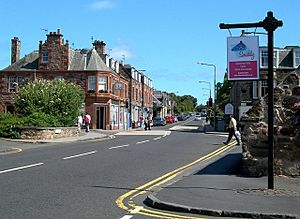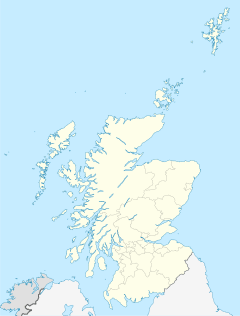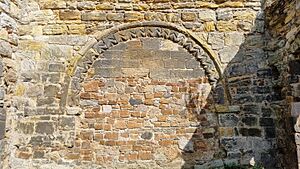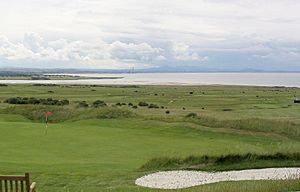Gullane facts for kids
Quick facts for kids Gullane
|
|
|---|---|
 Gullane Village, looking along the A198 |
|
| Population | 2,810 (2020) |
| OS grid reference | NT486830 |
| Civil parish |
|
| Council area |
|
| Lieutenancy area | |
| Country | Scotland |
| Sovereign state | United Kingdom |
| Post town | Gullane |
| Postcode district | EH31 |
| Dialling code | 01620 |
| Ambulance | Scottish |
| EU Parliament | Scotland |
| UK Parliament |
|
| Scottish Parliament |
|
Gullane is a town on the southern shore of the Firth of Forth in East Lothian, on the east coast of Scotland. People say its name like "GUL-ən" or "GHIL-ən".
There has been a church in the village since the 800s. You can still see the old church ruins from the 1100s at the west end of the village. This church was left empty after many sandstorms made it unusable. A new church in Dirleton took its place.
Gullane Bents is the village's amazing beach. It has won awards and is backed by big sand dunes. Some shrubs like sea-buckthorn have grown a lot on these dunes recently. Gullane is also part of the John Muir Way. This is a long-distance footpath that follows the coast between Musselburgh and Dunglass.
Many older people live in Gullane. But it also attracts young families and people who work in Edinburgh. Gullane is becoming a popular place for people to live and travel to work in nearby Edinburgh. Edinburgh is about 22 miles (35 km) away. Even though transport to the village is not great, more homes are being built. Gullane has a village hall and many shops. There is a primary school in Gullane. Older children go to secondary school about 5 miles (8 km) away in North Berwick.
What's in a Name?
The exact origin of the name Gullane is not fully known. It might come from the Scottish Gaelic words Gualainn or A' Ghualainn. However, this is probably not the case. The East Lothian area did not have many Gaelic speakers. People there mostly spoke Old English, Middle English, or Early Scots.
The village used to be called Golyn. So, the name might come from a Brythonic language word. This could be lyn or linn, meaning "lake." This name might have come from a lake that used to be near the old church.
The name Golyn could also come from the Middle English word gōl. This word means "boundary" or "limit." This might be because Golyn parish was one of the most northern places with Anglo-Saxon influence in Britain. Areas north of the Firth of Forth were controlled by the Picts or Gaels. We don't know if the area was named Golyn before or after Scotland took control. The church was built around 1170. This was after East Lothian became part of the Kingdom of Scotland. But people at that time might have still seen themselves as Anglo-Saxons or English.
Interesting Buildings
Greywalls Hotel was built in 1901. It was designed by Sir Edwin Lutyens. The gardens were designed by Gertrude Jekyll.
The Scottish Fire and Rescue Service used to have their training school in Gullane. It moved to new buildings in Cambuslang in 2013.
The Old St Andrews Church is a roofless ruin. It stands at the west end of the village. Most of its walls are still standing. The church was built between 1150 and 1200. It was likely built by the de Vaux family. The church was left empty after 1612. Lord Erskine of Dirleton asked to build a new church in Dirleton. He said sand dunes were covering the old church. In 1827, the Yule family used the chancel (the part of the church near the altar) as a private burial ground. They blocked the arch leading to it.
The Gullane War Memorial was put up in 1914. This was very early in World War I. It showed how much the community was affected by the war. Names were added to the monument as the war went on. Sir Robert Lorimer designed this special monument.
Golfing Fun
Gullane is famous for its golf courses. It is home to Muirfield, a very well-known golf course. Muirfield has hosted The Open Championship many times, most recently in 2013.
Besides Muirfield, Gullane has several other golf courses. At the Gullane Golf Club, there are three 18-hole courses. These courses are built on a large grassy hill that used to be a volcano. A mix of these courses hosted the Scottish Open and Ladies Scottish Open in 2018.
From the top of the hill on each course, you can see amazing views. You can look over Aberlady and Aberlady Bay towards Edinburgh. You can also see the Forth Bridge and the coast of Fife. The Lomond Hills are also visible. A famous artist named Frank W Wood painted a view of Gullane in 1933.
Next to Gullane Number 3 course, you'll find the Luffness Golf Club course. There is also a special Children's Course for younger players.
Famous People from Gullane
- Ronnie Corbett, a well-known comedian and TV star.
- Andrew Driver, a professional football player.
- Quintin Jardine, a famous crime novelist.
- Sydney Mitchell, an architect.
- Ann Stokes, a ceramic artist, was born here in 1922.
See also
 In Spanish: Gullane para niños
In Spanish: Gullane para niños





